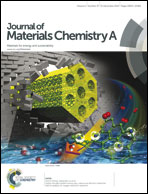Facile synthesis of scalable pore-containing silicon/nitrogen-rich carbon composites from waste contact mass of organosilane industry as anode materials for lithium-ion batteries
Abstract
A series of pore-containing silicon/nitrogen-rich carbon composites are successfully synthesized via a simple method by using the waste contact mass of organosilane industry as the pore-containing silicon source, followed by acid washing to remove the impurities and ball milling to obtain silicon particles with appropriate particle size. Gelatin is employed as the carbon precursor to gain the nitrogen-rich carbon. The pore-containing silicon/nitrogen-rich carbon composites with different ratios of pore-containing silicon and nitrogen-rich carbon are investigated as anode materials for Li-ion batteries. It was found that the composite displayed the best electrochemical performance when the weight ratio of the pore-containing silicon particles and gelatin reached 1 : 4. It exhibits a reversible capacity of 748 mA h g−1 after 100 cycles at a current density of 100 mA g−1 and 457 mA h g−1 at 600 mA g−1, much higher than those of commercial graphite.


 Please wait while we load your content...
Please wait while we load your content...